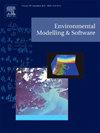用于在线水文和水质监测数据清理的 STL-DBSCAN 集成算法
IF 4.8
2区 环境科学与生态学
Q1 COMPUTER SCIENCE, INTERDISCIPLINARY APPLICATIONS
引用次数: 0
摘要
在线水文和水质监测数据对于水环境管理(如评估和建模)越来越重要。然而,在线监测数据往往包含错误或不完整的数据集,从而影响其业务使用。在这项研究中,我们开发了一种基于黄土季节-趋势分解(STL)和基于密度的噪声应用空间聚类(DBSCAN)的自动数据清理算法。STL 可识别并纠正时间序列中较为明显的异常现象,DBSCAN 则可对其进行进一步细化,其中采用了反向近邻法来提高聚类精度。为了改进异常检测,采用了两级残差判断阈值。该算法已成功应用于中国上海的三个水库,溶解氧和 pH 的精确率达到 0.91,召回率达到 0.81。所提出的算法可用于环境监测数据的清洗,具有较高的准确性和稳定性。本文章由计算机程序翻译,如有差异,请以英文原文为准。
Integrated STL-DBSCAN algorithm for online hydrological and water quality monitoring data cleaning
Online hydrological and water quality monitoring data has become increasingly crucial for water environment management such as assessment and modeling. However, online monitoring data often contains erroneous or incomplete datasets, consequently affecting its operational use. In the study, we developed an automated data cleaning algorithm grounded in Seasonal-Trend decomposition using Loess (STL) and Density-Based Spatial Clustering of Applications with Noise (DBSCAN). STL identifies and corrects more obvious anomalies in the time series, followed by DBSCAN for further refinement, in which the reverse nearest neighbor method was employed to enhance the clustering accuracy. To improve anomaly detection, a two-level residual judgment threshold was applied. The algorithm has been successfully applied to three reservoirs in Shanghai, China, achieving the precision rate of 0.91 and recall rate of 0.81 for dissolved oxygen and pH. The proposed algorithm can be potentially applied for cleaning of environment monitoring data with high accuracy and stability.
求助全文
通过发布文献求助,成功后即可免费获取论文全文。
去求助
来源期刊

Environmental Modelling & Software
工程技术-工程:环境
CiteScore
9.30
自引率
8.20%
发文量
241
审稿时长
60 days
期刊介绍:
Environmental Modelling & Software publishes contributions, in the form of research articles, reviews and short communications, on recent advances in environmental modelling and/or software. The aim is to improve our capacity to represent, understand, predict or manage the behaviour of environmental systems at all practical scales, and to communicate those improvements to a wide scientific and professional audience.
 求助内容:
求助内容: 应助结果提醒方式:
应助结果提醒方式:


